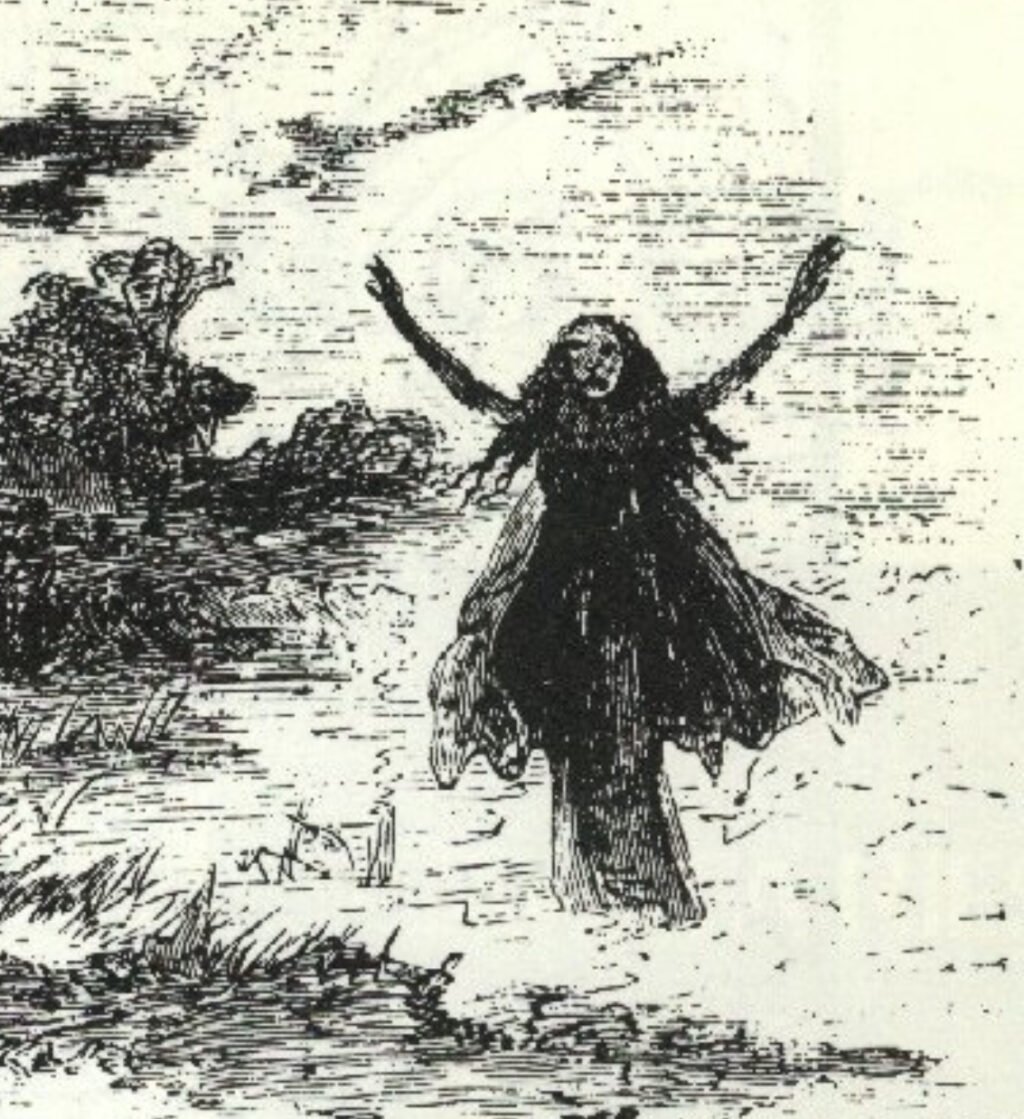
The Akan people, Ghana’s largest ethnic group, hold a deep belief in a variety of spirits, each with its own unique role. These include “saman” (ghosts), “abowatsia/amotia” (dwarfs), “amokye” (destiny spirits), and even different categories of ghosts like “saman kɛntsɛn” (hovering ghosts) and “saman pa” (good ghosts). Among these diverse spiritual figures, one stands out as particularly significant, yet often less discussed. That is ‘Samamberwa’.
Samamberwa, whose name translates to “old woman ghost,” or “a ghost that is an old woman”, is much more than a mere spiritual figure. Within Akan tradition, she plays a crucial role in the lives of young girls approaching puberty. As a guardian spirit, Samamberwa is intimately connected to the important rites of passage that mark a girl’s transition into womanhood. It’s believed that if a girl fails to undergo these rites, Samamberwa may intervene, even causing distress until the proper ceremonies are performed. This article will explore Samamberwa’s place within Akan spiritual beliefs and look into the meaning of her connection to these vital puberty rituals.

Among the Akan people, various rites of passage mark significant life stages. While all are important, including the likes of naming ceremonies, marriage rites, and death rites, the puberty rite, known as “Bragor,” holds a particularly prestigious place as it signifies the important transition from childhood to adulthood.

Before the puberty rite (Bragor) is performed, the Akans consult with spiritual authorities on behalf of the young women about to transition into adulthood. These consultations are often led by priests and priestesses of the Twelve Apostles Church Ghana, also known as “Nankaba” or “Awoyo.” These priests and priestesses are highly respected figures in the community, and are believed to connect the physical and spiritual worlds. They are considered key figures in spiritual consultations, and people visit their premises, known as “Gardens” seeking guidance for various spiritual problems.
The consultation with the priests and priestesses focuses on each young woman’s “Samamberwa.” These spiritual leaders communicate with the Samamberwa in the spirit world to determine her specific demands for the upcoming rite. These demands are then met by the girl’s family through a sacrificial offering known as “Salaka.” The Salaka typically consists of items deemed appropriate by the Samamberwa, which can include fowl, coins (both old and new), traditional foods, and spiritual ornaments. Sometimes, even prepared traditional dishes like “ɛtɔ” or “tɔ” (mashed yam or plantain with palm oil) are included.

These Salaka offerings are placed in designated locations like roadsides, parks, or forests. It is believed that the Samamberwa, being a spirit, will come and consume the offerings. While no one physically sees the spirits partake, the belief is that by daybreak, the Samamberwa will have accepted the Salaka. Afterward, the remaining physical items, including the coins, may be collected by people or animals, with the animals often consuming the food portions.
Sometimes, the Samamberwa herself guides the priest or priestess, indicating the precise location for the Salaka offering. If these instructions are not followed, the Samamberwa may manifest within the physical body of the young woman, or even another woman connected to her who is eligible for the ritual. In such instances, the Samamberwa essentially takes on the role of a priestess in her element, directly communicating the specific requirements for the Salaka placement.
I have seen firsthand how powerful Samamberwa’s influence can be. In one instance, a young woman who resided mostly in Tema’s Samamberwa, appeared at her family’s house in Takoradi where they had gathered for her puberty rite. The Samamberwa, however, instructed the family to return to Tema for the Salaka offering. The Samamberwa manifested like a warrior and issued a stern warning. The family, heeding her instructions, traveled back to Tema to perform the Salaka before returning to Takoradi to complete the remaining steps of the rite.
If a young woman refuses to undergo the Bragor rite, it’s believed that her Samamberwa will haunt her. The Samamberwa may appear in the young woman’s dreams, and even in her waking hours, particularly when she is alone or isolated, such as in a closed room. When such visitations occur, the family typically arranges for the rite to be performed quickly to prevent further hauntings.
Finally, on the last day, the young women undergoing the rite, known as “Asakyima,” are taken to a river or other body of water for a last cleansing or bathing ceremony. The first one happen at home. During this ritual, an older woman shaves the pubic hair of each girl, and the hair is then thrown into the flowing water. The belief is that the river carries these offerings to each girl’s respective Samamberwa. Upon receiving them, the Samamberwa bestows a form of protection upon the young women, who are now considered adults.
In Ahanta culture, the role of the Samamberwa during funerals is significant and rooted in tradition. When a body is being prepared for burial and laid in state, the presence of the Samamberwa becomes apparent. This spiritual entity manifests through an individual, often appearing like a fetish priest or priestess in their fierce element. The Samamberwa is believed to possess the ability to communicate beyond ordinary human capability, seeking to uncover the truth behind the deceased’s death.
During such occurrences, the possessed individual is compelled to reveal information regarding the cause of death, particularly if foul play or wrongdoing is suspected. This revelation is crucial as it aims to identify those responsible for the death. Following a confrontation with the Samamberwa possesed person, the individual is traditionally sent to the Garden or Nankaba, where their mouth is ritually made to speak truths that may otherwise remain hidden.
Interestingly, the outcomes of these rituals are often mysterious, with the specifics of what is revealed by the possessed individual kept confidential. It is believed that this process allows justice to be sought and closure to be achieved for the deceased and their family. After that, the person who was possessed goes back to their normal life as if nothing happened. Notably, females are commonly noted to be highly possessed by the Samamberwa during these ceremonies.
Samamberwa, the “old woman ghost” of Akan tradition, is far more than a figure of folklore. She embodies a powerful connection to the transition from girlhood to womanhood, playing a vital role in the lives of young Akan women. From demanding the proper performance of puberty rites to bestowing protection upon their completion, Samamberwa’s influence is crucial in Akan spirituality. While her methods may seem mysterious to those outside the culture, her presence is a tangible reality for the Akan people. She serves as a reminder of the enduring power of tradition, the importance of respecting ancestral beliefs, and the profound spiritual significance of rites of passage.
Editor: Ama Gyesiwaa Quansah






The Akan ethnic group is very large, spanning across several regions and communities. The Twelve Apostles Church Ghana, also known as “Nankaba” or “Awoyo” is a relatively modern day church and not a common church. It is therefore not found in even up to a quarter of Akan communities. Before that church came to be, and in the communities where they don’t exist, how is the Samanberwa contacted?
Thank you very much for your input. If you could observe, you could see cleary that the 12 Apostle Church is a blend of modern day christianity and African Traditional Religion. Our traditional priests were perfroming these roles and are still perfroming alongside the 12 Apostle priests